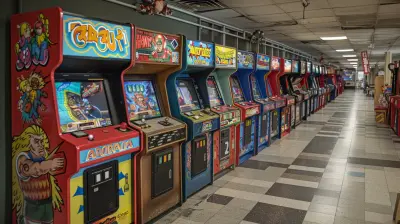Designing Crafting Systems That Don't Overwhelm Players
24 September 2025
Crafting systems are the peanut butter and jelly of game mechanics — they just make the whole experience feel fuller. Whether you're mixing potions, forging epic swords, or whipping up a tasty health regen dish, crafting adds depth to a game world. But here's the thing — if done wrong, it can leave players scratching their heads or rage-quitting halfway through.
Ever jumped into a game, opened the crafting menu, and immediately closed it because it looked like a spreadsheet exploded? Yeah, you're not alone.
In this post, we're diving deep into how to design crafting systems that are engaging, rewarding, and — most importantly — not overwhelming. We’ll look at what makes crafting in games fun, where devs often go wrong, and how you can strike that perfect balance between complexity and accessibility.
Why Crafting Matters in Games
Before we break down the “how,” let’s talk about the “why.” Why even bother adding a crafting system to your game?Crafting gives players agency. It hands them the reins and lets them create their own path forward. Instead of just finding weapons and items, crafting allows players to make gear, potions, tools — you name it. It’s about personalization and ownership.
But here’s where things get tricky: not everyone wants to feel like they need a chemistry degree to make a healing salve. If the system is too complex, casual players bounce. If it’s too simple, hardcore fans yawn.
So how do you design a crafting system that hits the sweet spot?
Start With Purpose, Not Features
One of the biggest mistakes game designers make is tossing in a crafting system just because it's trendy. Don’t do that.Instead, ask yourself:
What role does crafting play in my game?
- Is it a core mechanic or just a nice bonus?
- Will players rely on it for survival, gear, or just cosmetic fluff?
- Is it a way to encourage exploration, trading, or resource management?
Define your purpose first. If crafting isn't central to your gameplay loop, then keep it light and rewarding. If it’s vital to progression, you’ll need to invest more time into making it deep but approachable.
KISS: Keep It Simple, Smarty
We’ve all seen those games where the crafting UI looks like the cockpit of a fighter jet. Way too many ingredients, IDs, tiers, and modifiers. It’s like trying to order coffee from a hipster café — too many options, zero clarity.Your mantra should be: simplicity breeds understanding.
Use Familiar Patterns
Borrow from real-life analogies. If you're crafting food, use cooking terms. Swordsmithing? Give them a forge, anvil, and some ore.People love systems that feel intuitive. So if boiling water in your game requires a fire crystal, moonstone, and level 3 alchemy, maybe pump the brakes a bit.
Don’t Overuse Ingredients
Limit the number of materials needed for basic recipes. There's no need for 15 kinds of tree bark just to make a stick.A good rule of thumb?
Use fewer than 5 materials per item in early to mid-game sections.
Let players build muscle memory with simpler recipes before introducing complex ones.
Progression Over Complexity
Crafting should grow with the player, not smack them in the face from the get-go.Tier-Based Unlocks
Use a tier system. Start players off with basic ingredients and simple recipes. As they progress, introduce more advanced ones that require unique resources or tools.It’s a slow-burn approach — similar to how you'd learn to cook in real life. You start with toast, not Beef Wellington.
Gradually introducing complexity makes players feel smart instead of stupid.
Skill Trees & Crafting Perks
Let players invest in the crafting system gradually. Unlock perks that make crafting faster, cheaper, or give bonus effects. This way, those who love crafting can dive deep, while those who don’t can still benefit without being forced to engage.UI/UX: Your Crafting System’s Best Friend
A user-friendly crafting interface is like a good map — players shouldn’t need a tutorial every time they open it.Key UI Must-Haves:
- Search bar: Nobody wants to scroll through 200 items.- Filters/sorting: Group by type, material, or usage.
- Recipe preview: Show what an item will look like and what materials are needed.
- Highlight missing ingredients: Grey out what you can't make but show how close you are.
- Autocomplete or suggest tools: If a player selects an iron ingot, show what they can do with it.
Good UX turns a chore into a charm.
Give Crafting a Narrative Purpose
Crafting doesn’t have to be a detached Excel sheet.Weave it into your world.
- Make players find blueprints in dungeons.
- Get recipes from quirky NPCs.
- Tie it into quests and progression.
If crafting feels connected to the lore or the story, players are more invested. Instead of being “that thing you do on the menu screen,” it becomes a meaningful part of the world.
Feedback Loops: Reward, Rinse, Repeat
One of the key ingredients in a successful crafting system is a solid feedback loop. Players need to feel rewarded every time they engage with it.How to Create Positive Feedback Loops:
- Craft it → Use it → Feel powerful- Craft more → Sell it → Get rich
- Craft gear → Beat boss → Get rare recipe
Whatever the loop, make it rewarding. Tying the loop into core game objectives (combat, trade, survival, etc.) ensures players feel it’s worth their time.
Add Surprise Without Confusion
A little mystery is fun. A lot of mystery? Not so much.Controlled Experimentation
Games like Minecraft use a discovery-based crafting system. That’s fun — to a point. But too much trial and error, and players run to a wiki.Instead, offer systems where they can:
- Unlock recipe hints after crafting items
- Combine known ingredients with modifiers for special variants
- Discover new recipes through exploration or NPC dialogue
Surprise them, but don’t blindfold them.
Avoiding the Grind Trap
Crafting should never feel like a full-time job.You know the drill — needing 200 Iron Ore for a sword and the drop rate is one per goblin. That’s not fun. That’s padding.
Balance your resource economy. Check your drop rates. Avoid excessive grind unless grind itself is meaningful and varied.
Better yet, introduce systems like:
- Bulk crafting
- Auto-gatherers
- Crafting bonuses for using rare gear
Let players progress without burnout.
Social Systems Enhance Crafting
Want to make crafting more engaging? Let players show off.- Crafting leaderboards
- Player-driven markets
- Crafting contests
- Custom naming or appearances for items
There's something magical about forging “Excalibur 2.0” and seeing your friend envy it. Social currency amplifies the reward.
Also — co-op crafting stations? Genius. Let friends collaborate on big builds or rare items. It creates shared momentum and memories.
Accessibility Is Not Optional
Not everyone experiences a game the same way. Colorblind modes, text-to-speech, readable fonts, and keyboard navigation are not “extra features” — they're essential.Good crafting systems are inclusive:
- Use high contrast in item icons.
- Don’t rely solely on color coding.
- Offer simplified modes or recipe pinning.
Make crafting something everyone can enjoy.
Failures to Learn From
Even beloved games have stumbled with crafting.Remember when Fallout 76 launched with a crafting system so bloated and vague it made nuclear physics look chill? Or when No Man’s Sky felt like a space-themed inventory simulator more than a game?
They both fixed their systems eventually — by cutting clutter, improving UI, and adding meaning.
The point is: more isn’t always better. Better is better.
Test With Actual Humans (Seriously)
Lastly, don’t design in a vacuum. What makes perfect sense to you might be spaghetti to someone else.- Run playtests.
- Watch players struggle.
- Take notes on what confuses or bores them.
- Iterate.
Crafting is one of those “easy to get wrong, hard to get right” systems. Testing is your safety net.
Final Thoughts
Designing crafting systems that don’t overwhelm players is a balance between simplicity and depth, clarity and complexity, function and fun.Start with a purpose. Build systems slowly. Make your UI clean. Tie it into your gameplay and world. And above all, keep things human — because at the end of the day, that’s who you’re designing for.
So next time you're designing potions, weapons, or even ornate furniture in your game, just remember: no one wants to feel like they’re assembling Ikea furniture blindfolded.
Make it intuitive. Make it rewarding. And most importantly — make it fun.
all images in this post were generated using AI tools
Category:
Video Game DesignAuthor:

Francesca West
Discussion
rate this article
1 comments
Mason Tucker
Great insights! Balancing complexity can enhance player enjoyment.
October 2, 2025 at 2:54 AM

Francesca West
Thank you! I'm glad you found it insightful. Balancing complexity is key to creating an enjoyable crafting experience!


